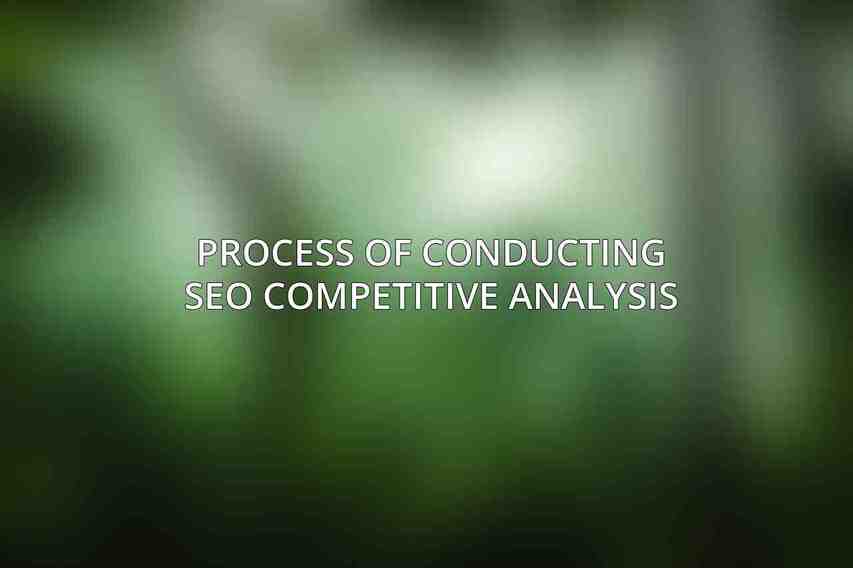Understanding and excelling in search engine optimization (seo) has become paramount for businesses seeking online visibility. seo competitive analysis plays a crucial role in shaping a successful digital strategy. this analysis involves evaluating competitors’ online presence to identify strengths and weaknesses, ultimately informing strategies to improve website visibility and attract more organic traffic. Conducting thorough SEO competitive analysis can give businesses a competitive edge in the digital world.
Definition of SEO Competitive Analysis
SEO Competitive Analysis is the process of evaluating the search engine optimization strategies of competitors to determine areas where they excel and areas where improvements can be made. It involves assessing elements such as keyword rankings, content quality, backlink profiles, and overall website performance to gain insights into competitor strategies and industry trends.
Importance of SEO Competitive Analysis in Digital Strategy
Where online visibility can make or break a business, engaging in SEO Competitive Analysis is crucial. By understanding how competitors approach SEO, businesses can identify gaps in their strategies and leverage opportunities to enhance their online presence. This analysis helps in setting realistic goals, refining SEO tactics, and staying ahead of the competition.
Benefits of Conducting SEO Competitive Analysis
The benefits of conducting SEO Competitive Analysis are multifaceted. By analyzing competitors’ strategies, businesses can:
– Gain insights into industry trends and best practices
– Identify potential keywords and content opportunities
– Benchmark their performance against competitors
– Improve website visibility and organic traffic
– Enhance overall digital marketing strategies for long-term success
Types of SEO Competitive Analysis
Understanding the different types of SEO Competitive Analysis is essential for a comprehensive evaluation of competitors’ strategies.
Direct Competitors Analysis
Direct Competitors Analysis involves evaluating businesses that offer similar products or services within the same target market. Key aspects of this analysis include:
- Identifying Direct Competitors: Utilize tools like SimilarWeb or SEMrush to identify direct competitors based on industry keywords.
- Comparative Analysis of Rankings, Content, and Backlinks: Evaluate competitor rankings for target keywords, the quality of their content, and the diversity and quality of their backlink portfolios.
Indirect Competitors Analysis
Indirect Competitors Analysis focuses on businesses that may not offer the same products or services but compete for the same target audience. This analysis includes:
- Identifying Indirect Competitors: Look for businesses targeting similar audiences or ranking for related keywords.
- Analysis of Overlapping Target Audiences and Search Queries: Assess how indirect competitors address the needs of shared target audiences and compete for visibility in search results.
Market Share Analysis
Market Share Analysis aims to estimate the share of organic search traffic captured by competitors. This analysis involves:
- Estimating Market Share: Use tools like Ahrefs or SEMrush to estimate the organic traffic distribution among competitors.
- Identifying Growth Opportunities and Gaps: Identify areas where competitors dominate the market and pinpoint opportunities for growth and market penetration.
Key Elements of SEO Competitive Analysis
To conduct a thorough SEO Competitive Analysis, businesses need to focus on essential elements that impact online visibility and search engine rankings.
Website Rankings
Website rankings are a fundamental aspect of SEO Competitive Analysis. Key considerations include:
- Identifying Target Keywords: Determine the keywords competitors are targeting and assess their performance.
- Analyzing SERP Positions of Competitors: Monitor competitor positions on the Search Engine Results Page (SERP) for target keywords.
- Monitoring Changes in Rankings Over Time: Track fluctuations in rankings to understand competitors’ SEO strategies and adapt accordingly.
Content Analysis
Content plays a pivotal role in SEO. When analyzing competitors’ content strategies, consider:
- Evaluating the Quality and Quantity of Content: Assess the relevance, depth, and engagement levels of competitors’ content.
- Analyzing Competitors’ Keyword Usage and Content Structure: Identify keyword usage patterns and content organization strategies that drive traffic.
- Identifying Linkable Assets and Engagement Metrics: Recognize high-performing content that attracts backlinks and engagement, impacting search visibility.
Backlink Analysis
Backlinks are crucial for SEO success. In backlink analysis, focus on:
- Identifying Competitors’ Backlink Sources: Discover where competitors acquire backlinks and assess the quality and relevance of linking domains.
- Evaluating Link Quality and Anchor Text Distribution: Analyze the diversity of anchor texts and the authority of linking domains.
- Uncovering Link Building Opportunities: Identify potential websites for link building, leveraging competitors’ existing backlink profiles.
Tools for SEO Competitive Analysis

Various tools are available to streamline the process of SEO Competitive Analysis and gather valuable insights for strategic decision-making.
Keyword Research Tools
Effective keyword research is essential for SEO success. Some popular keyword research tools include:
- Keyword Planner (Google Ads): A powerful tool for discovering relevant keywords, search volumes, and competition levels.
- SEMrush Keyword Magic Tool: Offers comprehensive keyword data, including related keywords, search volume, and keyword difficulty.
- Ahrefs Keyword Explorer: Provides detailed keyword analysis, including search volume trends, keyword difficulty, and competitive metrics.
Website Analysis Tools
To assess website performance and SEO metrics, consider using the following tools: Check this blog on Complete Guide on Conducting an SEO Competitive Analysis
- Google Search Console: Offers valuable insights into website visibility, indexing status, and search performance on Google.
- Ahrefs Website Auditor: Conducts in-depth website audits, highlighting on-page SEO issues, technical errors, and performance improvements.
- Moz Pro Site Crawl: Helps identify technical SEO issues, duplicate content, and crawlability problems for improved website performance.
Backlink Analysis Tools
Backlink analysis tools are essential for understanding competitors’ backlink profiles and identifying link building opportunities. Consider using:
- Ahrefs Backlink Checker: Provides comprehensive data on backlinks, referring domains, and anchor text distribution.
- SEMrush Backlink Audit: Offers insights into competitors’ backlink profiles, toxicity scores, and link growth trends.
- Moz Link Explorer: Analyzes backlink profiles, domain authority, and link equity distribution for competitive link building strategies.
Process of Conducting SEO Competitive Analysis

The process of conducting SEO Competitive Analysis involves several steps to gather insights and formulate effective strategies. Dive deeper into How to Benchmark Your Website Using SEO Metrics
A. Gather Data from Relevant Sources
Utilize a combination of tools and resources to collect data on competitors’ SEO performance, including keyword rankings, backlink profiles, and content strategies.
B. Analyze Competitors’ Websites and Content
Thoroughly evaluate competitors’ websites, content quality, structure, and keyword targeting to identify areas of strength and improvement. Explore further with Best Tools for SEO Competitive Analysis in 2024
C. Identify Strengths and Weaknesses of Competitors
Highlight competitor strengths in SEO strategies, content marketing, and backlink acquisition, while identifying weaknesses that present opportunities for your business.
D. Develop SEO Strategies to Gain Competitive Advantage
Based on the insights gathered from the analysis, develop tailored SEO strategies to enhance website visibility, improve search rankings, and attract targeted organic traffic.
Best Practices for SEO Competitive Analysis
To make the most of SEO Competitive Analysis, businesses should adhere to best practices that ensure a comprehensive and strategic approach to analyzing competitors’ SEO strategies.
A. Analyze Regularly and Keep Up with Industry Trends
Regularly monitoring competitors’ SEO strategies and industry trends enables businesses to adapt quickly to changes, identify emerging opportunities, and refine their own strategies for sustained success.
B. Use a Variety of Data Sources for a Comprehensive Analysis
Leverage a diverse set of tools and data sources to gather comprehensive insights into competitors’ SEO performance, ensuring a holistic understanding of the competitive world.
C. Quantify and Measure Results to Track Progress
Establish key performance indicators (KPIs) to measure the effectiveness of SEO strategies implemented based on competitive analysis. Regularly track and analyze results to refine strategies and achieve long-term SEO goals.
SEO Competitive Analysis is a fundamental practice for businesses aiming to thrive in the competitive digital world of 2024. By understanding competitors’ strategies, leveraging valuable insights, and implementing data-driven SEO tactics, businesses can enhance their online visibility, attract organic traffic, and stay ahead of the competition.
Recap of the Importance and Benefits of SEO Competitive Analysis
SEO Competitive Analysis offers businesses unparalleled benefits, including:
– Strategic insights into competitors’ SEO tactics
– Identification of growth opportunities and competitive advantages Check this blog on Enhancing Your SEO with Competitive Keyword Analysis
– Enhanced digital marketing strategies and improved search visibility
Encouragement to Apply the Concepts to Enhance Digital Strategy
As businesses navigate the ever-evolving realm of SEO and digital marketing, integrating SEO Competitive Analysis into their strategic framework is essential for sustainable growth, increased online presence, and competitive edge in the digital marketplace. Embrace the insights gained from competitive analysis to refine and optimize your SEO strategies for success.
Businesses can embark on a journey towards seo excellence and digital prosperity in the dynamic world of 2024.
Frequently Asked Questions
What is SEO competitive analysis?
SEO competitive analysis is the process of evaluating the strengths and weaknesses of your competitors’ websites in order to improve your own search engine optimization strategy.
Why is SEO competitive analysis important for beginners?
SEO competitive analysis helps beginners understand their competitors’ strategies, identify new opportunities, and optimize their own website for better search engine rankings.
How can beginners conduct SEO competitive analysis?
Beginners can conduct SEO competitive analysis by analyzing competitors’ keywords, backlink profiles, and content strategies using tools like SEMrush, Ahrefs, and Moz.
What are some key metrics to look at during SEO competitive analysis?
Key metrics to look at during SEO competitive analysis include organic traffic, domain authority, backlink quality, keyword rankings, and on-page optimization.
How often should beginners perform SEO competitive analysis?
Beginners should perform SEO competitive analysis regularly to stay updated on competitors’ strategies and make necessary adjustments to their own SEO strategy.

